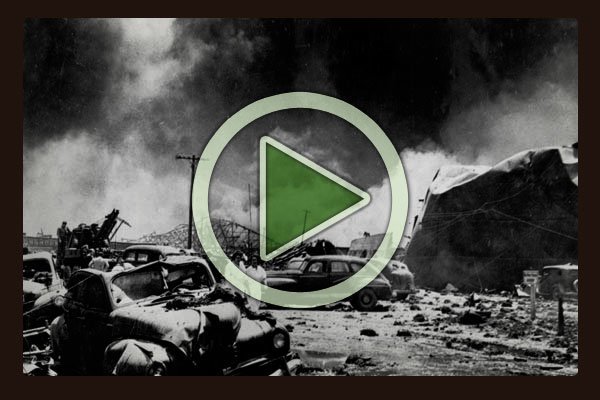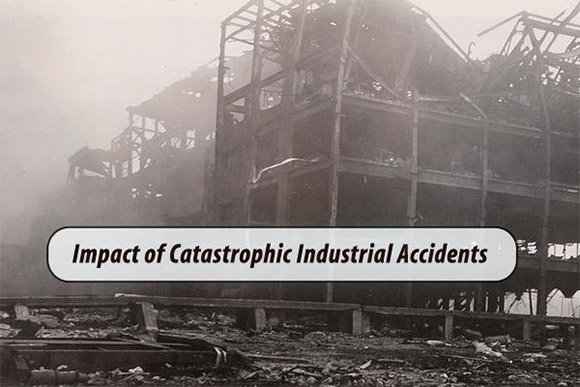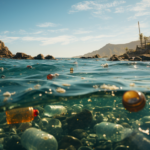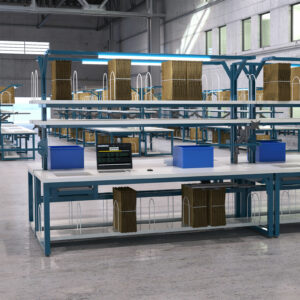It was an important industrial port city built up quickly during an economic boom. Residential housing was adjacent to heavy industry and shipping. There was a fire. Firefighters were called in. Then disaster struck: two impossibly large explosions. In the first explosion, approximately 2300 tons of ammonium nitrate detonated, setting off fires and explosions in adjacent oil storage facilities and completely destroying the Monsanto Chemical Company plant. Then the Union Carbide plant burned. Then, unbelievably, a second explosion, possibly larger than the first fueled by over 900 tons of ammonium nitrate and 1,800 tons of sulfur as well as fertilizer stored in adjacent warehouses on the dock area. This fire led to further conflagrations as one by one oil storage tanks caught on fire.

All but one of the firefighters in the city were killed. The blast was so strong that windows were blown out over 12 miles away. Two airplanes flying overhead were destroyed, with no survivors. At least 581 people were killed in the explosions, and another 8,000 or so were injured. Entire residential neighborhoods were utterly destroyed and further afield hundreds of homes were damaged.

Are you thinking of the catastrophic industrial accident last week in northern China’s industrial port city of Tianjin? The parallels are striking, but in this case we’re talking about the 1947 disaster on the Gulf Coast in Texas City, Texas — the deadliest industrial accident on record in the United States and the largest non-nuclear explosion here at home.
We don’t yet have a lot of details about the exact sequence of events that led to the explosion in Tianjin, and, given the Chinese government’s strong control over information, it’s possible that many key details will never become public, at least not for a long time. But in an era of social media it’s possible to infer a lot of information from the available videos that have been shared on the Internet.
We spoke to an expert who manufacturers and installs gas leak detection systems at large industrial plants, such as refineries in Texas City and across the US. He had a strong suspicion that the explosion was in fact eerily similar to the Texas City disaster — he further speculated that Tianjin firefighters may have encountered a small fire of calcium carbonate that lacked adequate emergency documentation of its contents (e.g. material safety data sheets). Our expert contends that if that was the case, trying to douse calcium carbonate with water would create an explosive acetylene gas mixture, which in turn might have set off stockpiled fertilizer stored in nearby shipping containers and warehouses. In our expert’s view, these would be the type of compounds needed to create such a large blast.
Our hearts go out to the first responders who lost their lives in the explosion and the residents who were killed or injured, as well as those who lost property and livelihood. If there was any positive outcome from the Texas City Explosion of 1947, it would have to be the increased level of safety awareness, emergency planning, and accident prevention programs that were implemented as a result. We already see signs the Chinese government is actively implementing these type of programs now, after this accident.
Concern About Long-Term Effects on the Environment, Especially the Watershed
As we wait to see how events in Tainjin unfold, one concern that takes more public precedence now than it would have after the Texas City disaster is the impact on water resources. The drought in the western United States has focused public attention on the importance of water– it’s such a scarce and precious commodity. It’s depressing to think that one long-term consequence of the Tainjin disaster may be that the chemicals have entered the region’s watershed, which could lead to a potentially long-term environmental disaster. But no nation is immune. If you asked someone if they thought that Japan would have such a catastrophic nuclear disaster as they did at the Fukushima Daiichi plant in 2011 after the Tohoku earthquake and tsunami, they probably would’ve said no. At least before the incident happened. Millions of gallons of water are passing through the radiation-tainted Fukushima Daiichi industrial site and then directly into the ocean.
As water becomes scarcer, we predict the public will demand greater accountability for industrial accidents. Climatologist project that climate change will significantly alter rainfall patterns. As a result, some futurists believe that what are termed today’s oil wars will be followed by global water wars, as this life-giving liquid becomes an ever more scarce commodity. Countries with strong financial resources, such as Saudi Arabia, have invested heavily in desalination plants. California has desalination projects on the table to address its own water shortages. And, although Texas has recovered from its recent drought, public planners are looking forward into the future and considering development of desalination plants on the coast such as a desalination plant for the University of Texas Medical Branch Hospital System in Galveston, Texas.
Of course, salt is just one element that needs to be removed for clean drinking water. There are many other chemicals and mineral contaminants that need to be considered, especially in Africa, where access to clean water continues to be an ongoing issue in poor communities. A clever concept made the news this past week: a book whose individual pages can be removed and used as a filter to remove contaminants. The paper is infused with nano-sized particles of silver to kill organisms. The project is still in the experimental stage.

Yet, despite the urgent need for clean drinking water, not everyone is convinced that introducing more nano-sized metal particles into the environment is such a good idea. It’s not hard to assume that these water filters will end up in a dump somewhere, where they can leach into the water supply. Already in the US there is increasing evidence that active ingredients from pharmaceuticals (both ‘used’ and ‘unused’) flushed down the toilets are entering our watersheds.
Amphibians may be the canary in the coal mine as they seem to be the most affected by endocrine changes in their hormone balance. Nano-sized particles may create a similar slow-motion environmental disaster as well. Researchers at MIT are studying how gold nano-particles can enter cells directly, as shown in the video above. Clearly, more research is needed to avoid another 21st century industrial accident.
At Formaspace, We take Safety Very Seriously
We invite you to join the roster of satisfied Formaspace technical, manufacturing and laboratory furniture clients — including Apple Computer, Boeing, Dell, Eli Lilly, Exxon Mobile, Ford, General Electric, Intel, Lockheed Martin, Medtronic, NASA, Novartis, Stanford University, Toyota and more.
Give us a call today at 800.251.1505 to find out more about the Formaspace line of built-to-order computer workstations, industrial workbenches, laboratory furniture, lab benches and dry lab/wet labs — as well as our design / furniture consulting services. Like all Formaspace furniture, it’s backed by our famous 12 year, three shift guarantee.










